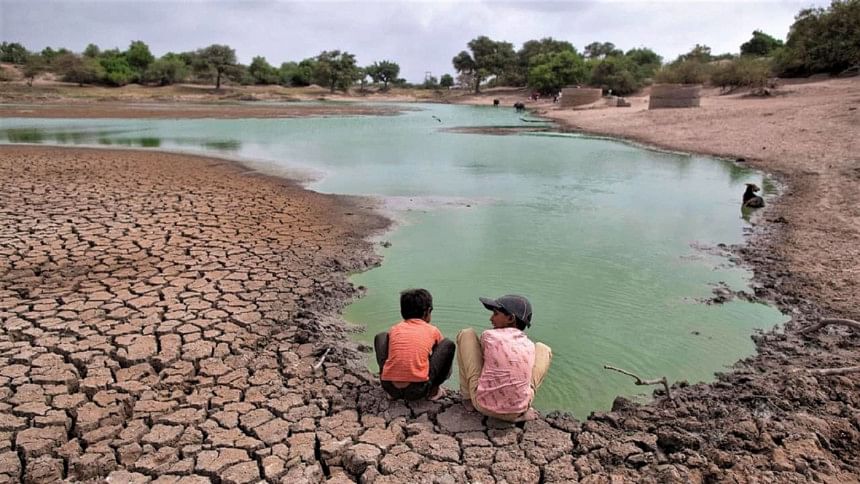From vulnerability to resilience to prosperity

The development gains and hard-earned productivity of Bangladesh are at risk of being inverted if the 1.5 degree Celsius limit of the Paris Agreement is breached. To that end, it remains imperative to equip vulnerable communities, key sectors and the government with vital instruments to bring about resilience and stability for all.
At the end of last year, Bangladesh's Prime Minister Sheikh Hasina became the Chair of the group of the 48 most vulnerable developing countries, called the Climate Vulnerable Forum (CVF), for the second time. A year into her two-year tenure, she has spoken on behalf of the group and will continue to do so, particularly at the upcoming COP26 to be held in Glasgow, UK in November, as well as at COP27 next year.
In her earlier first term as the CVF Chair, she had initiated a discussion amongst member countries to shift the prevailing narrative of the group from stressing their vulnerability to making themselves more climate resilient. This has indeed been the changing narrative for CVF countries over the last few years.
After PM Hasina took over for her second period as CVF President, she initiated another discussion amongst the group to try to shift the narrative once again from resilience to prosperity. The difference between them is that resilience focuses on managing the adverse risks of climate change, while prosperity implies overcoming those risks and becoming prosperous despite those prevailing risks. The 48 CVF countries are now internalising this concept and many of them are considering preparing their own Climate Prosperity Plans, following the lead of Bangladesh.
The Prime Minister has offered to have Bangladesh draft, develop and share the first such plan, which she named after the Father of the Nation Bangabandhu Sheikh Mujibur Rahman, as the Mujib Climate Prosperity Plan (MCPP). The MCPP has just been drafted and is being shared with all relevant stakeholders, including government ministries and agencies, experts, civil society and development partners. So far, quite a few excellent suggestions have been received and the Plan will be revised after the feedback is incorporated.
What are some of the broad areas that the MCPP is aiming to address? The first point to stress is that it does not replace any of our existing plans such as the Eighth Five Year Plan, the Perspective Plan to 2041 or the Delta Plan to 2100, but rather aims to supplement those existing plans and accelerate their implementation. So it will not create the need to operationalise any new bureaucratic institution to deliver or ensure its implementation.
The Mujib plan will also not be like the country's Paris nationally determined contribution or NDC, which orientates climate action around commitments to cut emissions. The Mujib plan is instead a strategy that explores the possibilities and potential of delivering robust socio-economic development while simultaneously maximising our climate resilience and various green opportunities. It will lay out the funding needs required from international, regional, public and private sources, as well as how the local economy can contribute, if the elements of the Mujib plan's vision for the future are to actually be realised.
The second important point to make is that it aims to achieve transformative change by enabling Bangladesh to leapfrog on a number of technological and economic fronts. This will be done on a five-plus-five-year format, where the first five years will be to lay the foundations for doing something new and different, and the second five years will be to actually put in the investments and deliver them. Although this may seem a farfetched proposition, it is based on the new generation of bigger and more stable wind turbines, such as those now being deployed by the UK and Denmark in the North Sea, and which can also withstand the cyclonic wind speeds in the Bay. The first five years will be used to explore the offshore wind energy profile and develop the feasibility of the array, while the second five years will be for bringing in the billions of dollars of investment it will need from global private sector investors.
Another proposal in the MCPP refers to the construction of strategic Mujib Energy Hubs, which will ensure the reconversion of sources of "dirty energy" such as coal, oil and diesel thermal power plants to high-tech green hydrogen production facilities—thus reinforcing power grid stability, providing cleaner burning fuels, ensuring the up-skilling of workers, and allowing the energy sector to capitalise on high-value strategic export products in the form of green hydrogen. This is in line with the International Renewable Energy Agency's new 1.5 degree Celsius pathway report stating solar and wind power generation will provide 68 percent of the entire global electricity demand. Moreover, a report by the Institute for Sustainable Futures at the University of Technology in Sydney completed a long-term scenario analysis, taking into consideration Bangladesh's land constraints, and showed that renewable energy production can reach 33 percent by 2030.
At the heart of the Mujib Plan, however, is the aim of accelerating adaptation and resilience actions. As a result, the plan promotes empowering locally-led efforts by communities that are most vulnerable to climate shocks through a range of new initiatives, including innovative financing instruments and capacity development programmes.
A second novel idea is for Bangladesh to gear up to access the trillions of dollars of global funds available for green investment, which Bangladesh has not been able to access yet. As the country is aspiring to graduate out of Least Developed Country (LDC) status over the next few years, we will no longer be eligible for grant funding and will have to access global investments, with improved regulations and capacity in our financial sector. The idea is to enhance the capabilities of the financial sector, both public and private, in order to access global green investment funds.
A third area of focus is on enhancing the quality of education and capacity building of our youth, in order to transform them into problem-solvers and not just job-seekers. This particular investment does not really need extra funding, but it does require a major shift in the status quo in our education sectors—all the way from primary to secondary to university and even higher professional levels of education. As iterated by academics and experts, the main paradigm shift will be a focus on quality instead of quantity.
Finally, the MCPP aims to uplift Bangladesh to reach middle-income status faster, which inevitably means graduating from LDC status and an end to reliance on grant-based support from our development partners. This also means not relying on intellectual inputs and technical support from foreign consultants and agencies, but rather relying on our own finances, as well as intellect, to chart our way towards prosperity over the coming decade.
Dr Saleemul Huqis Director of the International Centre for Climate Change and Development at the Independent University, Bangladesh. He also chairs the Expert Advisory Group of the CVF.

 For all latest news, follow The Daily Star's Google News channel.
For all latest news, follow The Daily Star's Google News channel. 



Comments